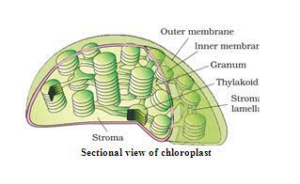Table of Contents
Chloroplast Definition
A chloroplast is a part inside cells that holds a green pigment called chlorophyll. This pigment catches sunlight and changes it into helpful energy, also making oxygen from water.
What is Chloroplast?
A chloroplast is a specialized structure found within plant cells and green algae. It is the site of photosynthesis, where light energy is converted into chemical energy, producing oxygen and energy-rich compounds. This process allows plants to make their food. The chloroplast structure comprises a double membrane, thylakoids (disc-like structures), and stroma (fluid-filled space).
The function of chloroplasts is to capture light energy and use it to convert carbon dioxide and water into glucose and oxygen. They contain chlorophyll, a green pigment that absorbs light for photosynthesis. Unlike animal cells, plant cells have chloroplasts due to their role in photosynthesis.
The difference between chlorophyll and chloroplast lies in their functions; chlorophyll captures light, while chloroplasts carries out photosynthesis. Similarly, mitochondria are energy producers, contrasting their role with chloroplasts. Chloroplast discovery is credited to Julius von Sachs in the 19th century, and their presence exclusively in plant cells is linked to their role in photosynthesis.
Chloroplast Diagram
The provided chloroplast diagram offers a visual representation of the chloroplast’s structure. It highlights the different components of the chloroplast, such as the outer and inner membranes, thylakoid membrane, stroma, and intermembrane space. This diagram of the chloroplast provides a clear depiction of its intricate arrangement within plant cells.

Chloroplast Function
Chloroplasts play crucial roles in plants and their cells. These functions include:
- Chloroplast Function in Plants: The most important task is photosynthesis, where chloroplasts convert light energy into chemical energy.
- Chloroplast Function in Plant Cells: These organelles are responsible for housing chlorophyll and facilitating the process of photosynthesis.
- Chloroplast Function Simple: Chloroplasts absorb light energy, transform it into chemical energy, and produce oxygen as a byproduct.
- Chloroplast Function in Animal Cells: Animal cells lack chloroplasts and cannot conduct photosynthesis like plants.
These functions collectively contribute to the survival and growth of plants by producing essential nutrients and energy through photosynthesis.
Chloroplast Structure
Chloroplasts are present in most plants and have an oval or biconvex shape. They’re located within plant cells’ mesophyll. The chloroplast’s size usually ranges from 4 to 6 µm in diameter and 1 to 3 µm in thickness. These organelles have two layers of membranes, including outer, inner, and space between them. You can find two main parts inside the chloroplast: grana and stroma.
- Grana:
Made of stacks of disc-shaped structures called thylakoids or lamellae.
Contain chlorophyll pigments and play a key role in chloroplast function. - Stroma:
- The homogenous matrix is similar to the cell cytoplasm.
- Holds grana and various substances like enzymes, DNA, and ribosomes
- Stroma lamellae connect thylakoid stacks (grana).
Chloroplast Structure Components
- Membrane Envelope: Consists of inner and outer lipid bilayer membranes.
The inner membrane separates stroma from intermembrane space. - Intermembrane Space: The gap between inner and outer membranes.
- Thylakoid System (Lamellae): Suspended in stroma, made of membranous sacs called thylakoids.
Thylakoid membranes contain green pigments (chlorophyll), vital for light dependent photosynthesis reactions.
Thylakoids are arranged in stacks called grana; each granum holds around 10-20 thylakoids. - Stroma: Colorless, alkaline, protein-rich fluid within the inner chloroplast membrane. Surrounds grana and plays a crucial role in various cellular activities.
- Grana: Stack of lamellae, essential sites for converting light energy into chemical energy.
- Chlorophyll: Green pigment aids the photosynthesis process.
Chloroplasts are crucial for plants as they harness sunlight to create energy, playing a significant role in the plant’s life cycle.
Frequently Asked Questions (FAQs) on Chloroplast
Why are chloroplasts only found in plant cells?
hloroplasts are present only in plant cells because they play a crucial role in photosynthesis, a process where plants make their own food using sunlight. Since animals get their energy from consuming plants or other animals, they don't need chloroplasts.
What is the function of chloroplasts?
The main job of chloroplasts is to perform photosynthesis. They capture sunlight and use it to turn carbon dioxide and water into glucose (sugar) and oxygen. This process provides energy and food for the plant.
Difference Between Chlorophyll And Chloroplast?
Chlorophyll is a green pigment found inside chloroplasts. It absorbs sunlight for photosynthesis. On the other hand, chloroplasts are the structures where chlorophyll and other components of photosynthesis are located.
Difference Between Mitochondria And Chloroplast?
Chloroplasts are responsible for photosynthesis, while mitochondria are responsible for cellular respiration, which releases energy from glucose. Both are organelles but have different functions and are found in different parts of the cell.
Who discovered chloroplasts?
Hugo von Mohl, a German botanist, discovered chloroplasts in plant cells in the 19th century. He observed these structures under a microscope and described their role in photosynthesis.





